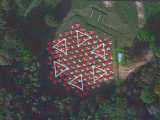OSWIN
Description of the radar set, tactical-technical characteristics

Figure 1. Panoramic image of the antenna array in Kuehlungsborn, Germany
(54°07'05.82" N 11°46'08.63" W)
(© 2014 Leibniz-Institut für Atmosphärenphysik)

Figure 1. Panoramic image of the antenna array in Kuehlungsborn, Germany
(54°07'05.82" N 11°46'08.63" E)
(© 2014 Leibniz-Institut für Atmosphärenphysik)
| Specifications | |
|---|---|
| frequency: | 53.5 MHz |
| pulse repetition time (PRT): | |
| pulse repetition frequency (PRF): | < 50 kHz |
| pulsewidth (τ): | 1 … 32 µs |
| receive time: | |
| dead time: | |
| peak power: | 90 kW |
| average power: | 4.5 W |
| height range: | (0.4) 1 … 18 km (65 … 95 km) |
| height resolution: | 150 m, 300 m, 600 m, 1000 m |
| accuracy: | |
| beamwidth: | 6 degrees |
| MTBCF: | |
| MTTR: | |
OSWIN
OSWIN (Ostsee-Wind-Radar, i.e. Baltic Sea wind radar) is a VHF radar to study the upper atmosphere, constructed and operated by the Institute of Atmospheric Physics in Kuehlungsborn (Germany). It was taken into operation in summer 1999th. The radar operates fully automatically and generates height profiles of the 3D wind vector and the reflectivity.
The antenna array is a phased array antenna from initially 144 single Yagis with 4 elements. They were positioned in a square arrangement groups each consisting of 4 individual antennas. The feeding lines to the antennas are all the same length. For receiving there are available 6 independently reconfigurable receiver channels. By controlling the phase-shifte of the six antenna groups, it is possible to swiwel the antenna pattern electronically in the four directions (North, South, East and West) in three zenith angles (7°, 13° and 20°).
After a renewal of the antenna array in spring 2014, this field consists of only 133 Yagi (each with three elements), which are arranged in a hexagonal structure. They are currently grouped into 19 antenna groups with each 7 Yagis. It is planned, to increase the number of the receiver channels gradually, from 6 to 19 (later to a number of 133) to provide digital beam forming of the antenna pattern. Next to the antenna array there is a container with the receiver channel electronics (in Figure 2 framed in green).
Picture gallery of OSWIN

Figure 2: Hexagonal structure: in each case
3 groups are currently summarized
by one receiving channel.
